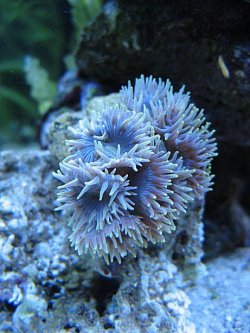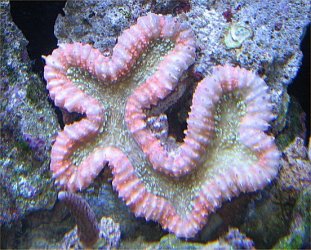You are using an out of date browser. It may not display this or other websites correctly.
You should upgrade or use an alternative browser.
You should upgrade or use an alternative browser.
Stef`s New Marine Tank
- Thread starter stefday
- Start date
I think I am starting to see aiptasia appearing in my tank.
Is this a problem and if so how do I control it?
I have seen aiptassia eating filefish in my lps. Are these effective and would they be compatable with my current set up?
I would be grateful for any advice.
Is this a problem and if so how do I control it?
I have seen aiptassia eating filefish in my lps. Are these effective and would they be compatable with my current set up?
I would be grateful for any advice.
Filefish aren't the best choice as their history of success in captivity is poor at best. You'd be better off with peppermint shrimp if your stock will not eat shrimp.
seffieuk
I used to be indecisive but now I'm not so sure!
Pink hysterix 
can I see a bit of a pink theme going on
Seffie x

can I see a bit of a pink theme going on
Seffie x
jtnova13
Fishaholic
copperband butterfly fish eat aiptasia, but they are not suitable for your size tank.
Also they are extremely picky eaters and once aiptasia is gone, it will probably die.
Also they are extremely picky eaters and once aiptasia is gone, it will probably die.
jtnova13
Fishaholic
any sort of rubbing either on rock or sand is not a good sign! They might have whitespot in their gills making it so you can't see them or something?
Readinds are :
pH 8.2
Nitrite 0
nitrate 20
Potassium 0
Magnessium 1200
Calcium 440
Strontium 12
KH 10
I did add some fish a couple of weeks ago and they were picked on straight away by 2 humbug damsels I had and quickly died. I returned the damsels to the local fish store.
What are the signs of whitespot and how do I try to cure it?
Any advice would be very welcome.
pH 8.2
Nitrite 0
nitrate 20
Potassium 0
Magnessium 1200
Calcium 440
Strontium 12
KH 10
I did add some fish a couple of weeks ago and they were picked on straight away by 2 humbug damsels I had and quickly died. I returned the damsels to the local fish store.
What are the signs of whitespot and how do I try to cure it?
Any advice would be very welcome.
ben1987
Fish Aficionado
white spot is a skin parasite


you will usually see if on their fins first.
HTH.
oh and lovely new corals too btw. i love the hysterix
Lifecycle
This parasite has a life cycle that has four stages (figure 1). When the parasite is embedded in the skin of a fish (figure 2) it is called the trophont stage. Here it appears as a distinct white spot about 1-2mm across (around the size of a grain of salt). The parasite has bored inside the tissues of the fish (it is not on the skin’s surface) and is hemispherical in shape and covered with minute cilia (figure 3). The parasite rotates inside the capsule it makes in the fishes skin tissues and, it is said, this movement contributes to irritation the parasite causes and the fish often flick against hard surfaces in an attempt to knock this parasite off. In severe infections this flicking can cause additional damage to the fish’s skin. During this stage the parasite is feeding on the host building up its nutritional reserves ready to break out of the skin and start the next stage of the life cycle as a free living trophont. The free living trophont always exits the host at night and has one goal in life - to find a suitable substrate to encyst into the theront. A suitable substrate can be the sand at the bottom of the tank, detritus in a filter or even the surface of living rock. If it does not find a suitable place to form the cyst within 3-4 hours it usually dies.
After about a week as the tomont about 200 infective theronts will have formed within the tomont. The tomont then ruptures releasing the theronts back into the water column where they seek a host. The theronts are attracted by light and move up the water column looking for a susceptible host to infect. After release the theronts are infective for about 24 hours.

you will usually see if on their fins first.
HTH.
oh and lovely new corals too btw. i love the hysterix
Readinds are :
pH 8.2
Nitrite 0
nitrate 20
Potassium 0
Magnessium 1200
Calcium 440
Strontium 12
KH 10
I did add some fish a couple of weeks ago and they were picked on straight away by 2 humbug damsels I had and quickly died. I returned the damsels to the local fish store.
What are the signs of whitespot and how do I try to cure it?
Any advice would be very welcome.
hi
your water needs at bit of care i would do a 25% water change for the nitrate
i would also rise your magnesium
what is the ammonia in the tank
i would qt all fish you get from now on and get odinex and start treating your tank to be onn the safe side as you dont want it to get worse
regards scott
seffieuk
I used to be indecisive but now I'm not so sure!
Your fish and corals will love them - probably feed about 3 x a week
Seffie x
Seffie x
Similar threads
- Replies
- 2
- Views
- 2K
- Replies
- 3
- Views
- 733
- Replies
- 17
- Views
- 3K
- Replies
- 43
- Views
- 5K
Most reactions
-
 384
384 -
 160
160 -
 155
155 -
 153
153 -
 149
149 -
 148
148 -
 131
131 -
 108
108 -
 106
106 -
 86
86 -
 63
63 -
 61
61 -
 57
57 -
 50
50 -
F
48



